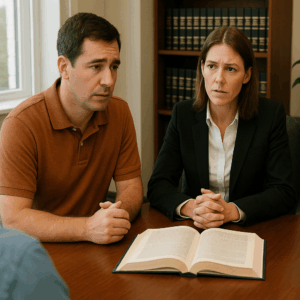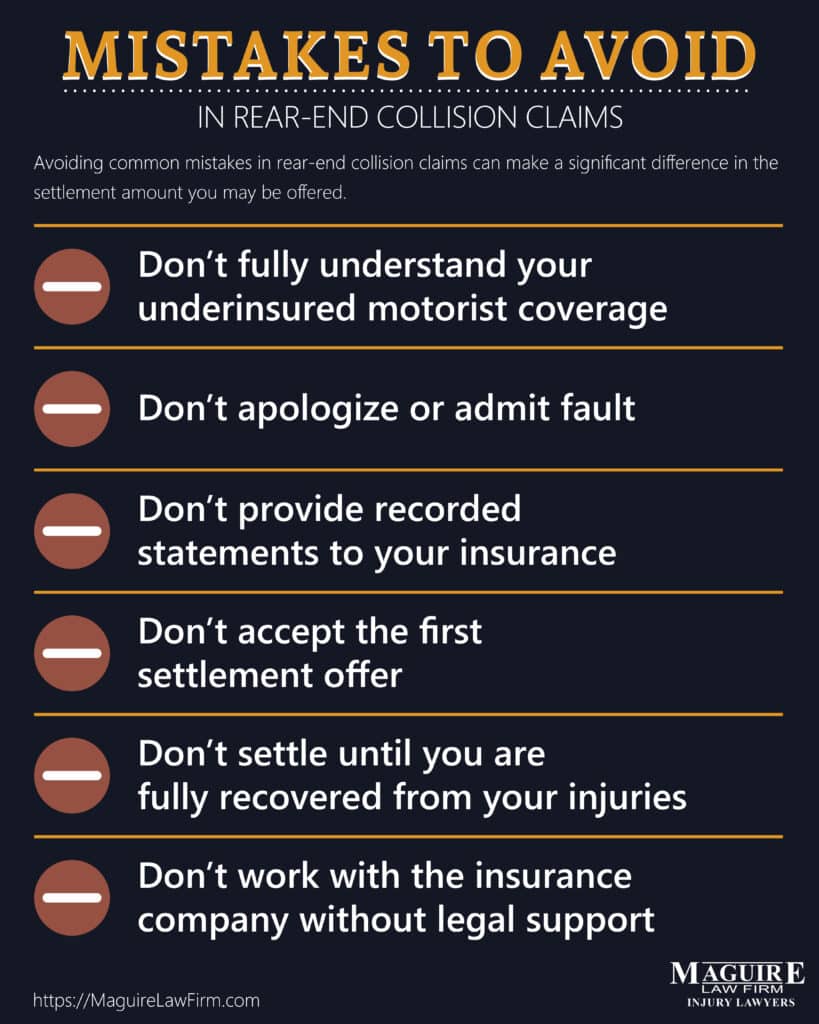
The average payout for a rear-end collision typically ranges from $2,000 to over $100,000. This raises the question: What is the average payout for a rear-end collision? It varies depending on injury severity, medical costs, and other key factors. In this article, we’ll explain what impacts these settlement amounts and help you understand what you might expect.
Key Takeaways
- Rear-end collision settlements vary significantly based on factors such as injury severity, medical expenses, and state laws, with amounts ranging from $2,000 to over $2 million.
- Key factors affecting settlements include medical costs, lost wages, and pain and suffering, with comprehensive documentation being essential for maximizing compensation.
- Legal representation can enhance settlement outcomes as experienced attorneys navigate the complexities of insurance claims and ensure victims receive fair compensation.

Hurt in an Accident? Hire Maguire
Hurt? You Need Our Help
Give us a call for a FREE & CONFIDENTIAL Case Review*
Understanding Rear-End Collision Settlements
Rear-end collision settlements are compensation amounts negotiated between the victim and the at-fault driver’s insurance company. These settlements cover various damages resulting from the accident, such as medical expenses, lost wages, and pain and suffering. The rear end collision settlement amounts can vary significantly based on the nature of the injuries and property damage involved, as seen in end collision settlement examples.
State-specific laws, the cost of living, and medical expenses also play substantial roles in determining settlement amounts. For instance, settlements in states with higher medical costs might be higher compared to those in states with lower costs.
Additionally, the clarity of liability in a rear-end accident can influence the ease of negotiating a fair settlement. Insurance policy limits often cap the maximum compensation available to victims, and insurers determine settlement amounts based on evidence, medical records, and policy limits.
Being aware of these factors can help victims obtain fair compensation after a rear-end collision.
Typical Settlement Ranges for Rear-End Collisions
Settlement amounts for rear-end collisions can vary widely based on the severity of the injuries sustained in rear-end car accidents.
For minor injuries, settlements typically range from:
- $10,000 to $50,000
- Soft-tissue injuries often yield between $2,226 and $3,000
- Low-speed collisions, which usually result in less severe injuries, often see settlements between $2,000 and $10,000.
For moderate injuries, such as herniated discs, the average settlement can be around $38,859, with high-impact collisions resulting in settlements between $20,000 and $50,000. These amounts reflect the more significant medical treatments and longer recovery times associated with moderate injuries.
Severe injuries, on the other hand, can lead to settlements ranging from $100,000 to over $2,000,000, with average settlements possibly exceeding $100,000. The variability in settlement amounts highlights the complex nature of each case and the importance of thorough documentation and legal guidance.
Knowing these typical settlement ranges enables victims to set realistic expectations and advocate for fair compensation. Each case is unique, and the final settlement amount will depend on various factors, including the specifics of the accident and the injuries sustained.
Key Factors Influencing Settlement Amounts
Several key factors influence the settlement amounts in rear-end collisions. These include the severity of injuries, medical expenses, and lost wages. More serious injuries tend to lead to higher settlements due to the extensive medical bills and treatment required.
Additionally, the at-fault driver’s insurance policy limits can cap the maximum settlement available to the victim.
Medical Expenses and Treatment Costs
Medical expenses make up a significant part of rear-end collision settlements. These costs encompass emergency treatment, hospital stays, diagnostic tests, rehabilitation, and physical therapy. Future medical expenses, including ongoing treatments, are also considered in settlement calculations. Accurate medical records are crucial as they detail the extent of injuries, treatments received, and future care costs to cover medical expenses.
Claimants must submit detailed medical records. Invoices outlining their ongoing care are also necessary to accurately assess medical expenses. Following prescribed medical treatment plans post-collision is crucial for fully supporting claims. This thorough documentation helps in covering all medical costs and securing a fair settlement.
Lost Wages and Future Earning Capacity
Lost wages are another key factor in determining settlement amounts. They cover compensation for time away from work and potential future losses due to the accident. Victims can claim lost income if they miss work because of a rear-end accident, including both temporary and permanent income losses, ensuring fair compensation for economic damages.
Evidence such as pay stubs and tax returns is necessary to substantiate lost wage claims. Severe cases may entitle victims to compensation for lost earning capacity, significantly increasing the settlement amount. This compensation covers wages lost during recovery and diminished future earnings.
Pain and Suffering Compensation
Pain and suffering compensation refers to non-economic damages, accounting for intangible effects like physical pain, suffering, and emotional distress. Factors influencing the amount include injury severity, recovery time, and emotional impact.
When determining pain and suffering damages, insurance companies assess various factors. They look at the severity of injuries, the length of recovery, and the impact on daily life. Various methods are used to calculate pain and suffering, including the multiplier method and other subjective assessments.
Psychological impacts such as anxiety, depression, post-traumatic stress disorder, and fear of driving again are common considerations in physical and emotional distress claims.

Hurt in an Accident? Hire Maguire
Hurt? You Need Our Help
Give us a call for a FREE & CONFIDENTIAL Case Review*
Examples of Rear-End Collision Settlements
Real-world examples of rear-end collision settlements can provide valuable insights into what victims might expect. For instance, in a case involving severe traumatic brain injury from a rear-end collision, the victim received a settlement of up to $3.2 million, accounting for extensive medical care and future needs. This case highlights the significant impact of severe injuries on settlement amounts.
In another example, a client with moderate injuries received $45,000 for treating soft tissue injuries, a concussion related to traumatic brain injuries, and lost wages due to a rear-end collision. This settlement reflects the costs associated with moderate injuries and the importance of documenting all medical treatments and lost income.
Meanwhile, a client with minor injuries from a rear-end accident received an $8,000 settlement after incurring low medical costs and a quick recovery.
A more substantial settlement of $150,000 was awarded to a victim who suffered a herniated disc requiring surgery and had long-term treatment needs following a rear-end crash.
These examples illustrate the wide range of settlement amounts based on the severity of injuries and the necessity of thorough documentation and legal guidance.
Legal Framework for Rear-End Collisions
The legal framework for rear-end collisions plays a crucial role in determining settlement amounts. In most cases, the driver at the back is usually deemed responsible for any resulting damages. This presumption of fault makes it easier for the victim to claim compensation. However, exceptions exist, such as cases where the front driver contributes to the accident through negligence.
Different states have varying comparative negligence laws that can affect how compensation is calculated. In a pure comparative negligence system, a driver can claim damages even if they are mostly at fault and are considered partially responsible. In modified comparative negligence states, recovery may be barred if the plaintiff’s fault exceeds a certain percentage, typically 50%.
Police reports, eyewitness accounts, and surveillance footage are commonly used to prove negligence in rear-end collisions.
Steps to Take After a Rear-End Collision
Knowing the steps to take after a rear-end car accident collision can significantly impact your car accident claim. Checking for significant injuries and seeking immediate medical attention for anyone hurt is critical.
Documenting the accident scene, filing a police report, and promptly reporting the accident to your insurer with details and documentation are all essential actions.
Seek Medical Attention Immediately
Seeking medical attention immediately after a rear-end collision is crucial. It helps document spinal cord injuries that may not be immediately apparent and ensures that you receive the necessary treatment, potentially avoiding unnecessary emergency room visits.
Following prescribed medical treatment plans post-collision supports your claims.
Document the Accident Scene
Documenting the accident scene is vital for supporting your insurance claim and establishing fault. Key evidence includes photos of the scene, vehicle damage, visible injuries, and witness contact information. Effective documentation involves taking photos of vehicle damage, skid marks, road signs, and noting the date, time, and weather conditions.
Collecting details such as weather conditions and witness contacts at the scene strengthens your claim. This thorough documentation aids in gathering evidence and helps to gather evidence, proving negligence, and securing a fair settlement.
File a Police Report
Filing a police report after a rear-end collision is crucial as it helps establish fault and supports insurance claims. A police report serves as an official record of the accident, essential for insurance claims and settlement negotiations.
Having a police report can streamline the claims process and the legal process by providing documented facts and evidence supporting your case.
Maximizing Your Settlement with Legal Representation
Legal representation significantly increases the likelihood of receiving a larger settlement after a rear-end collision. Experienced car accident attorneys like those at Maguire Law Firm provide essential legal guidance and effectively navigate complex insurance processes, allowing victims to better understand their rights and potential compensation options. They also gather necessary evidence and handle communication with insurance companies, which can reduce stress for the victims.
Maguire Law Firm operates on a contingency fee basis, meaning we only get paid if the case is successful, ensuring our incentive aligns with the client’s outcome. Insurance companies typically aim to minimize payouts; attorneys help to counter this by holding them accountable and improving the chances of securing higher settlements.
Hiring an experienced personal injury attorney enhances settlement outcomes and allows clients to focus on recovery while their case is professionally managed by personal injury attorneys, personal injury lawyers, and personal injury protection.
Common Mistakes to Avoid in Rear-End Collision Claims
Avoiding common mistakes in rear-end collision claims can make a significant difference in the settlement amount.
- Many victims fail to understand the extent of their insurance coverage, particularly regarding uninsured or underinsured motorist provisions.
- Do not apologize or admit fault at the scene, as it can negatively impact their ability to recover damages in car accident claims, especially if the at-fault driver is involved.
- Do not provide recorded statements to insurance adjusters before consulting a lawyer can lead to unfavorable outcomes.
- Do not accept the first settlement offer without understanding that your total costs can leave you undercompensated in the long run.
- Avoid settling early after a rear-end collision, as the full extent of injuries may not be clear. Evaluating the full extent of damages is crucial to protect your rights and secure fair compensation.
- Don’t try to work with the insurance company without speaking to an attorney. Our team at Maguire Law is here to help you.
Frequently Asked Questions
What is the average settlement for minor injuries in a rear-end collision?
The average settlement for minor injuries in a rear-end collision generally falls between $10,000 and $50,000. Soft-tissue injuries specifically can average settlements ranging from $2,226 to $3,000.
How does the severity of injuries affect settlement amounts in rear-end collisions?
The severity of injuries directly influences settlement amounts in rear-end collisions; more serious injuries typically result in higher settlements due to the increased costs of medical care and treatment needed.
Why is it important to file a police report after a rear-end collision?
It is important to file a police report after a rear-end collision to establish fault and support your insurance claims with documented evidence. This step ensures that you have a formal record of the incident, which can be vital in resolving disputes.
How can legal representation maximize my settlement after a rear-end collision?
Legal representation can significantly maximize your settlement after a rear-end collision by offering expert legal guidance, managing insurance communications, and ensuring all documentation is comprehensive and accurate. This support can lead to a more favorable outcome in your case.
What are some common mistakes to avoid in rear-end collision claims?
To effectively handle rear-end collision claims, avoid admitting fault at the scene, understand your insurance coverage, refrain from giving recorded statements to adjusters without legal advice, and do not accept the first settlement offer without assessing all associated costs. Prioritizing these precautions can significantly impact your claim’s outcome.
Last updated Friday, May 9th, 2025






